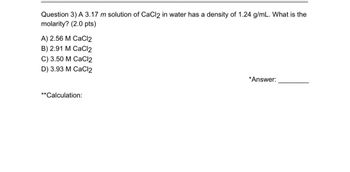
Chemistry
10th Edition
ISBN: 9781305957404
Author: Steven S. Zumdahl, Susan A. Zumdahl, Donald J. DeCoste
Publisher: Cengage Learning
expand_more
expand_more
format_list_bulleted
Question

Transcribed Image Text:Question 3) A 3.17 m solution of CaCl2 in water has a density of 1.24 g/mL. What is the
molarity? (2.0 pts)
A) 2.56 M CaCl2
B) 2.91 M CaCl2
C) 3.50 M CaCl2
D) 3.93 M CaCl2
**Calculation:
*Answer:
Expert Solution
This question has been solved!
Explore an expertly crafted, step-by-step solution for a thorough understanding of key concepts.
Step by stepSolved in 2 steps with 2 images

Knowledge Booster
Similar questions
- Question 17 Determine the molarity of the following solution: 1.9 grams of KCI in 4.5 L of solution 0.42 M 31.5 M 0.025 M 5.6 x 103 Marrow_forwardQuestion 10 If 18.0 g of hydrochloric acid (HCI) is dissolved in water to make 0.500 L of solution, what is the molarity of the solution? A 0.724 M 0.986 M 3.20 M D 36.0 Marrow_forward7:53 Question 2 of 9 Submit Convert the concentration of 0.700 | M Na2SO4 to g/mL X STARTING AMOUNT ADD FACTOR ANSWER RESET *( ) 0.001 1000 g/mL 6.022 x 1023 mol Na2SO4 1 mL 119.05 g Na2SO4 0.0994 M Na2SO4 0.700 g Na* 142.04 mol Na* 0.0833 L 99.4 83.3 Tap here or pull up for additional resourcesarrow_forward
- Im completely lostarrow_forwardWhat is the total number of moles of solute in 0.7 liters of a 8.2 M solution of NaCl? _______molarrow_forwardA solution was prepared by mixing 40.00 mL of 0.100 M HNO3 and 160.00 mL of 0.200 M HNO3. Calculate the molarity of the final solution of nitric acid. Molarity = Submit Answer M Try Another Version [References] I item attempt remaining Emarrow_forward
- What is the formula for calculating molarity? Question 15 options: M=mols of solute/Liters of solution M=Liters of solution/mols of solute M=mols of solution/Liters of solute M=Liters of solute/mols of solutionarrow_forwardIf 18.0 ml of 2.15 M HNO3 is diluted to a volume of 1.35 L what is the concentration of HNO3 in molarity (M)arrow_forward
arrow_back_ios
arrow_forward_ios
Recommended textbooks for you
 ChemistryChemistryISBN:9781305957404Author:Steven S. Zumdahl, Susan A. Zumdahl, Donald J. DeCostePublisher:Cengage Learning
ChemistryChemistryISBN:9781305957404Author:Steven S. Zumdahl, Susan A. Zumdahl, Donald J. DeCostePublisher:Cengage Learning ChemistryChemistryISBN:9781259911156Author:Raymond Chang Dr., Jason Overby ProfessorPublisher:McGraw-Hill Education
ChemistryChemistryISBN:9781259911156Author:Raymond Chang Dr., Jason Overby ProfessorPublisher:McGraw-Hill Education Principles of Instrumental AnalysisChemistryISBN:9781305577213Author:Douglas A. Skoog, F. James Holler, Stanley R. CrouchPublisher:Cengage Learning
Principles of Instrumental AnalysisChemistryISBN:9781305577213Author:Douglas A. Skoog, F. James Holler, Stanley R. CrouchPublisher:Cengage Learning Organic ChemistryChemistryISBN:9780078021558Author:Janice Gorzynski Smith Dr.Publisher:McGraw-Hill Education
Organic ChemistryChemistryISBN:9780078021558Author:Janice Gorzynski Smith Dr.Publisher:McGraw-Hill Education Chemistry: Principles and ReactionsChemistryISBN:9781305079373Author:William L. Masterton, Cecile N. HurleyPublisher:Cengage Learning
Chemistry: Principles and ReactionsChemistryISBN:9781305079373Author:William L. Masterton, Cecile N. HurleyPublisher:Cengage Learning Elementary Principles of Chemical Processes, Bind...ChemistryISBN:9781118431221Author:Richard M. Felder, Ronald W. Rousseau, Lisa G. BullardPublisher:WILEY
Elementary Principles of Chemical Processes, Bind...ChemistryISBN:9781118431221Author:Richard M. Felder, Ronald W. Rousseau, Lisa G. BullardPublisher:WILEY

Chemistry
Chemistry
ISBN:9781305957404
Author:Steven S. Zumdahl, Susan A. Zumdahl, Donald J. DeCoste
Publisher:Cengage Learning

Chemistry
Chemistry
ISBN:9781259911156
Author:Raymond Chang Dr., Jason Overby Professor
Publisher:McGraw-Hill Education

Principles of Instrumental Analysis
Chemistry
ISBN:9781305577213
Author:Douglas A. Skoog, F. James Holler, Stanley R. Crouch
Publisher:Cengage Learning

Organic Chemistry
Chemistry
ISBN:9780078021558
Author:Janice Gorzynski Smith Dr.
Publisher:McGraw-Hill Education

Chemistry: Principles and Reactions
Chemistry
ISBN:9781305079373
Author:William L. Masterton, Cecile N. Hurley
Publisher:Cengage Learning

Elementary Principles of Chemical Processes, Bind...
Chemistry
ISBN:9781118431221
Author:Richard M. Felder, Ronald W. Rousseau, Lisa G. Bullard
Publisher:WILEY